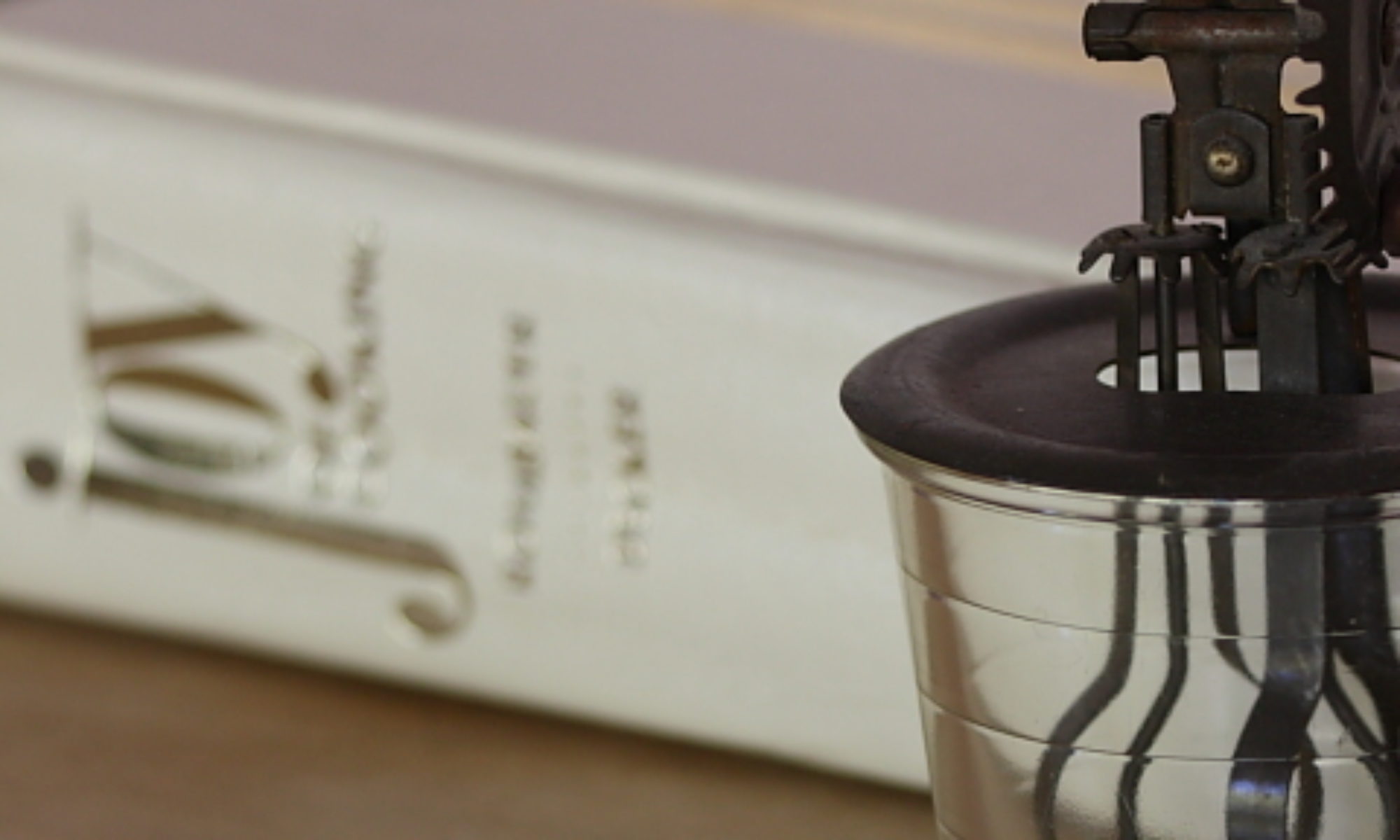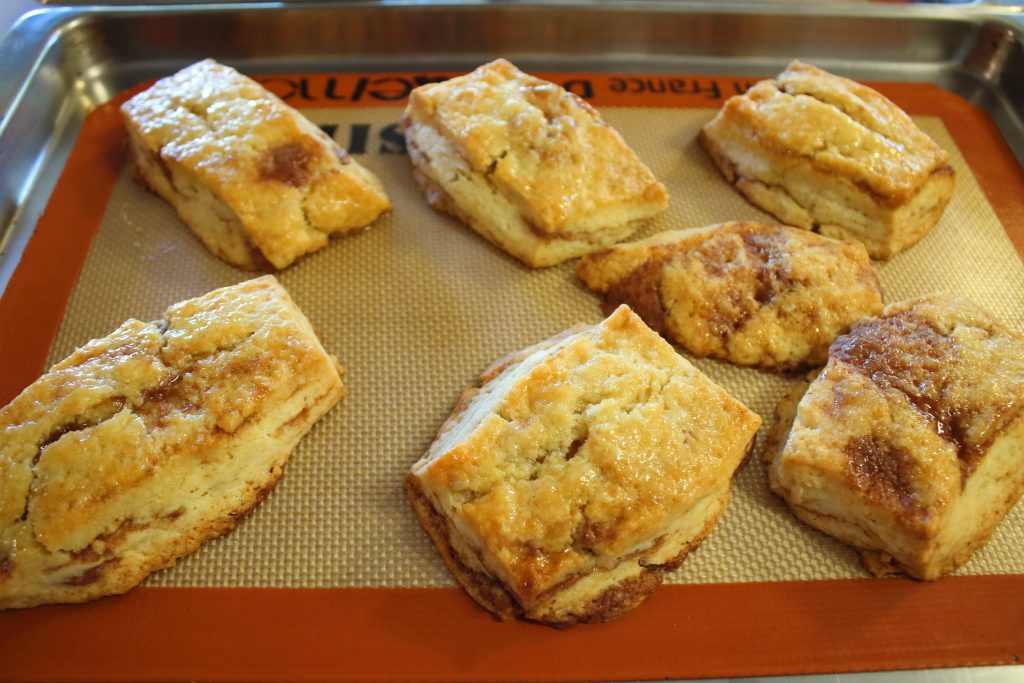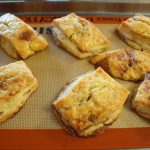
When people give up part of their day, you want to give them something in return. It’s only fair. So, when people came to attend a short meeting on a Saturday, we sent down a dozen of these scones; that way, they could have a little bite if they were feeling peckish. Since the plate came back nearly empty, we figure they were a success. And, after tasting them, we’re sure that you’ll want to try them out, too.
This recipe comes from Thomas Keller’s Bouchon Bakery, with co-author Sebastian Rouxel, which we just bought (used) recently. We rarely buy cookbooks, as most only have a few recipes that we might ever make; however, we have bought most of Thomas Keller’s books. Why? Simply stated, the recipes just work exactly as written, and the end result is always terrific, if not the best we’ve had. Really.
Today, we’re not just providing you with one recipe, but two: You can use this recipe to make Cinnamon Honey Scones, or, you can omit the cinnamon honey block, and make plain scones. Either way, you’ll be happy.
Cinnamon Honey Scones
Ingredients
Cinnamon Honey Block
- 30 g all-purpose flour (3 Tbs)
- 30 g sugar (2 1/2 Tbs)
- 4 g ground cinnamon (1 1/2 tsp)
- 30 g cold butter, cut into 1/4-inch cubes (2 Tbs)
- 20 g honey (1 Tbs)
Scone Dough
- 152 g all-purpose flour (1 cup + 1 1/2 Tbs)
- 304 g cake flour (2 1/4 cups + 2 Tbs)
- 2 1/2 tsp baking powder (12.5 g)
- 1/2 tsp baking soda (2.5 g)
- 91 g sugar (3/4 cup + 3 1/2 Tbs)
- 227 g cold butter, cut into 1/4-inch cubes (1 cup or 2 sticks)
- 135 g heavy cream (1/2 cup + 1 1/2 Tbs)
- 135 g créme fraîche or homemade sour cream (1/2 cup + 2 Tbs); see note
Honey Butter Glaze
- 57 g unsalted butter (4 Tbs or 1/2 stick)
- 20 g honey (1 Tbs)
Instructions
Cinnamon Honey Block
- In a medium bowl, whisk together flour, sugar, and cinnamon.
- Add butter cubes, and, using your fingers, work the butter into the mixture until no large pieces remain.
- Add honey and stir into a uniform paste.
- Transfer to a piece a plastic wrap and shape into a block 4 inches square and 1/4-inch thick. Wrap tightly and freeze for at least 2 hours.
Scone Dough
- Place all-purpose flour in the bowl of a stand mixer fitted with the paddle attachment.
- Sift cake flour, baking powder, baking soda, and sugar over the flour.
- Place bowl on stand and mix on low for about 30 seconds.
- Turn off mixer, add butter, and pulse to start combining. Mix on low until no large pieces of butter remain, about 3 minutes.
- With the mixer on low, slowly add heavy cream and créme fraîche and mix until a dough forms and sticks to the paddle.
- Turn out dough onto a clean work surface.
- Cut cinnamon honey block into 1/4-inch cubes and distribute over the scone dough. Use the heel of your hand to smear the dough and cubes together, folding and turning over about 5 times.
- Transfer dough to a large piece of plastic wrap and cover with another piece of plastic wrap. Shape into a block about 7 1/2×10 inches. Wrap tightly and refrigerate for at least 2 hours.
- Remove dough and cut into 5 long strips, each about 1 1/2 inches wide. Cut each strip into 4 blocks about 2 1/2 inches long. Transfer to a baking sheet lined with parchment or silicone baking mat. Freeze at least 4 hours, preferably overnight. Once frozen, the scones can be transferred to an airtight container and kept frozen for a month,
- Preheat oven to 350°F. Arrange scones on parchment-lined baking, leaving about an inch of space between them.
- Bake 30 minutes, rotating sheets from top to bottom and front to back halfway through, or until golden brown.
Honey Butter Glaze
- In a small saucepan, melt butter over over low heat without stirring. Once melted, skim foam from the surface,
- Place honey in a small bowl, and carefully pour butter over it, trying to leave the milk solids behind in the pan.
- Stir until combined and brush over scones immediately after they come out of the oven.
- Let scones cool completely on the baking sheets.
Notes
Ingredient discussion:
Note that most of the ingredients are listed by weight first, which shows how we measure them. For ingredients in a large quantity, such as flour, we weigh them. For small quantities, such as the baking soda, we find it easier to use a measuring spoon. You may be daunted by weighing ingredients, especially with such precise amounts, but it’s actually easier than using measuring cups. Really. Once you get used to using a scale, you’ll never go back.
Procedure in detail:
Cinnamon Honey Block. We recommend that you make this two days before you plan to bake the scones. You don’t have to; realize, though, that it needs to freeze for several hours before it goes into the scone dough, so plan ahead. We figure that it’s so easy to make, you might as well make it when you have a few minutes, then freeze it for later in the week.
Whisk dry ingredients. In a medium bowl — you’ll want to get your fingers in there in a minute — combine the flour, sugar, and cinnamon and whisk (or stir) together until uniform. Looks pretty much like cinnamon sugar, doesn’t it? If you left out the flour, you’d have cinnamon sugar to sprinkle over hot buttered toast. Another time.
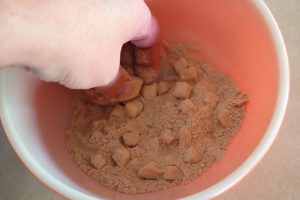
Cut in butter. Distribute the butter pieces over the top, and toss them around to coat. Now, get in there with your fingers and rub the butter into the mixture until no large pieces remain. Try to work quickly so the butter doesn’t melt from the heat of your hands. With this small amount of butter, that shouldn’t be a problem.
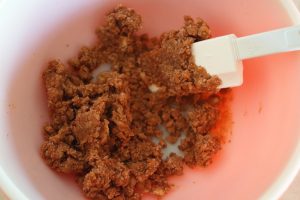
Stir in honey. Pour the honey over the top. If you’re using a scale, you know how easy this is: place the bowl on the scale, press the tare (or zero) button, then slowly pour in honey until you have 20 grams. No sticky spoons, no sticky fingers, no mess. A scale helps you work clean. Use a spatula to stir together the mixture into a paste. It’ll stay grainy from the sugar, so don’t think you’ll have a smooth paste; just make sure that all the sugar and flour are moistened by the honey.
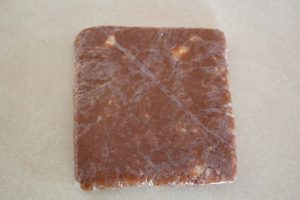
Shape and freeze. Turn out the mixture onto a piece of plastic wrap. It’s sticky, so this is the easiest way to shape it into a small block. Fold the plastic wrap over the mixture and press it down. Repeat pressing and folding over parts of the plastic until you’ve made a 4-inch square block about 1/4 inch thick. It’ll be fine if it’s a bit misshapen; you’ll cut it into pieces later, anyway. Wrap tightly and freeze at least 2 hours.
Scone dough. Realize that this has to chill for a few hours, and it needs to freeze for a few hours, so the scone dough should be made the day before you want to bake. This might seem to be a disadvantage, but, it’s really an advantage. Make the dough one day, then have fresh scones the next morning by simply popping them out of the freezer and into the oven. What could be better?
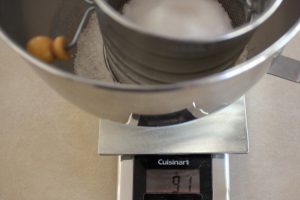
Sift dry ingredients. Do you really need to sift the ingredients? Well, no, but don’t blame me if you have a lump of baking soda in the middle of a scone. So, break out the sifter and use it. Place the all-purpose flour (you could sift that, too, if you want) in the bowl of a stand mixer fitted with paddle attachment, and sift in the cake flour, baking powder, baking soda, and even the sugar. Again, this is where using a scale really makes it easy. You can place the sifter right in the bowl, place everything on the scale, zero it, and scoop in each ingredient until you get the proper amount, zeroing the scale after each addition. Then it’s just sift, sift, sift.
Mix dry ingredients. Attach the bowl of dry ingredients to the mixer and mix until combined, about 15 seconds. Or even 30 seconds.
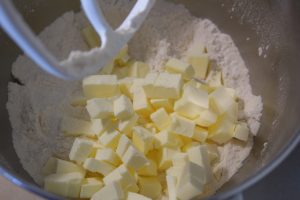
Add butter. It’s a bit troublesome to cut this much butter into 1/4 inch cubes, but here’s how we did it. First, cut a stick of butter into 4 planks lengthwise. Each will be about 1/4 inch thick. Next, cut each plank into 4 long strips. Cut each strip into a bunch of pieces. Repeat with the second stick of butter. Strew these pieces over the flour. Now comes the tricky part: pulse the mixer to start incorporating the butter. Some flour is likely to spew out, and there’s not a lot you can do about it, except to kind of pulse the mixer. Once the butter is starting to mix in, turn the mixer on low and let it run until all the butter is incorporated and no large pieces remain, about 3 minutes.
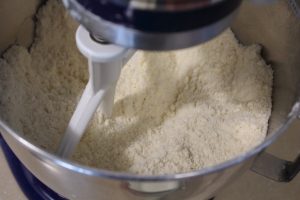
Add liquids. For ease, we just measured the créme fraîche and heavy cream into a large measuring cup before adding it to the mix. With the mixer on low, slowly add the heavy cream and créme fraîche, mixing until a dough is formed and sticks to the paddle attachment, about 30 seconds. Scrape down the sides and check the bottom of the bowl for dry ingredients and mix those in, too.
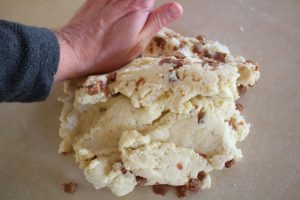
Shape and refrigerate. Turn the dough out onto a work surface. Remove the Cinnamon Honey Block from the freezer and cut it into 1/4-inch cubes. Sprinkle the cubes across the dough, and, using the heel of your hand, smear the dough together. It’s fine that the frozen blocks break up a bit. Use a bench knife to lift and fold part of the dough over, and smear the dough together again. Continue folding and smearing the dough several more times, then form into roughly a rectangle shape. Scrape the dough up and place on a large piece of plastic wrap, then place a second piece of plastic wrap over the top. Use your hands and a rolling pin, if needed, to shape the dough into a block about 7 1/2 inches by 10 inches. Wrap tightly with the plastic and refrigerate 2 hours.
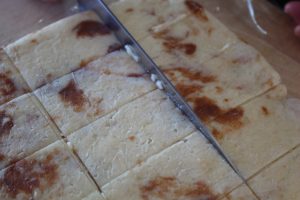
Cut and freeze. Remove the dough from the refrigerator and cut lengthwise into 5 strips, each about 1 1/2 inches wide and 10 inches long. Cut each strip into 4 blocks each about 1 1/2 inches by 2 1/2 inches. Place the blocks on baking sheets covered with parchment or silicone baking mats, wrap with plastic, and freeze for at least 2 hours, but preferably overnight. Once frozen, you can transfer the scones to a plastic bag and keep frozen for about a month.
Preheat oven to 350°F. Line baking sheets with parchment or silicone baking mats.
Bake. Place the frozen scones on the prepared baking sheets, leaving about an inch of space between each scone. Bake for about 30 minutes, rotating the sheets from top to bottom and front to back halfway through, or until the scones are golden brown.
Honey butter glaze. We almost skipped this part. We didn’t think it would add that much to the scones. We were wrong, and we don’t want you to skip this step, either. It’s really easy to make, and you’ll be able to whip it up quickly while the scones bake, so just make it. You’ll be glad you did.
Melt butter. We’re really going to be making something similar to clarified butter; however, we won’t strain it as carefully. Place the butter in a small saucepan over low heat and melt, without stirring, about 10 minutes. The butter should have separated into 3 parts. The lowest layer will be water and milk solids, the middle layer is the clarified butter, and the top layer is lighter milk solids (I think that’s the case). You want the middle layer for the glaze.
Skim. Use a spoon to skim off as much of the top layer as you can, or are patient enough to remove, and set the butter aside.
Pour butter over honey. Place the honey in a small bowl, and, gently and carefully, pour the clarified butter over the top, trying to leave all the milk solids behind in the pan. Stir together the honey and butter until uniform.
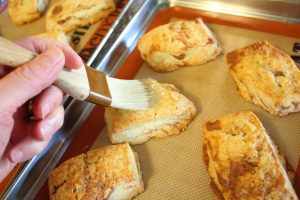
Glaze. As soon as the scones come out of the oven, brush the tops with the honey butter glaze. Let cool completely on the baking sheets before serving.
It might seem as if there’s a lot of work needed to make these scones, but it’s really pretty simple. The thing it does take is a bit of advance planning, which, for us, meant making the Cinnamon Honey Block one evening, making and freezing the scone dough the next day, and, finally, baking the scones on the third day. While it might seem time-consuming, none of the steps take very long; the rest of the time the dough is chilling, freezing, or baking, which only requires minimal effort on your part. That said, as with most recipes from Thomas Keller, these are a really, really good. Light, a bit crumbly, a bit crisp from the glaze, bites that have a nice cinnamon taste, bites that are just plain scone — everything just combines to make a scone that’s not only tasty, but interesting to eat. Five stars.
